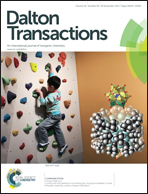Platinum-catalyzed reduction of amides with hydrosilanes bearing dual Si–H groups: a theoretical study of the reaction mechanism†
Abstract
A platinum-catalyzed amide reduction through hydrosilylation with 1,2-bis(dimethylsilyl)benzene (BDSB) was investigated on a theoretical basis. While the platinum-catalyzed hydrosilylation of alkenes is well known, that of carbonyl groups rarely occurs. The only exception involves the use of bifunctional hydrosilanes having dual, closely located Si–H groups, which accelerate the hydrosilylation of carbonyl groups, leading to successful reduction of amides to amines under mild conditions. In the present study, we determined through density functional theory calculations that the platinum-catalyzed hydrosilylation of the C![[double bond, length as m-dash]](https://www.rsc.org/images/entities/char_e001.gif) O bond proceeds via a Pt(IV)-disilyl-dihydride intermediate with an associated activation energy of 29.6 kcal mol−1. Although it was believed that the hydrosilylation of carbonyl groups does not occur via the classical Chalk–Harrod cycle, the computational results support a mechanism involving the insertion of the amide C
O bond proceeds via a Pt(IV)-disilyl-dihydride intermediate with an associated activation energy of 29.6 kcal mol−1. Although it was believed that the hydrosilylation of carbonyl groups does not occur via the classical Chalk–Harrod cycle, the computational results support a mechanism involving the insertion of the amide C![[double bond, length as m-dash]](https://www.rsc.org/images/entities/char_e001.gif) O bond into a Pt–H bond. This insertion readily occurs because a Pt–H bond in the Pt(IV)-disilyl-dihydride intermediate is highly activated due to the strong σ-donating interaction of the silyl groups. The modified Chalk–Harrod mechanism that occurs preferentially in rhodium-catalyzed hydrosilylation as well as the ionic outer sphere mechanism associated with iridium-catalyzed amide reduction were both safely ruled out as mechanisms for this platinum-catalyzed amide reduction, because of the unexpectedly large activation barrier (>40 kcal mol−1) for the Si–O bond formation.
O bond into a Pt–H bond. This insertion readily occurs because a Pt–H bond in the Pt(IV)-disilyl-dihydride intermediate is highly activated due to the strong σ-donating interaction of the silyl groups. The modified Chalk–Harrod mechanism that occurs preferentially in rhodium-catalyzed hydrosilylation as well as the ionic outer sphere mechanism associated with iridium-catalyzed amide reduction were both safely ruled out as mechanisms for this platinum-catalyzed amide reduction, because of the unexpectedly large activation barrier (>40 kcal mol−1) for the Si–O bond formation.


 Please wait while we load your content...
Please wait while we load your content...